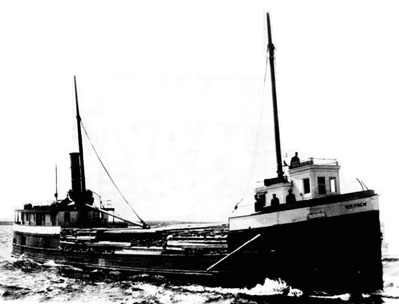
|

|

|
| Thew |
Run Down in Fog
The crash was hardly felt by the crew of the
steel steamer William Livingstone
The Livingstone's skipper, Capt. D. P. Craine, said he didn't bother to stop because
he did not believe the smaller vessel involved, the 140-foot propeller W. P. Thew, was damaged.
"I didn't know the
Thew was in need of help," Craine later told a board of inquiry at Detroit.
Captain Craine was strongly criticized
after the Livingstone steamed off, leaving the small vessel in a sinking condition.
The two boats sideswiped because
their wheelsmen were blinded by thick fog off Thunder Bay Island in Lake Huron early in the morning on June 22, 1909.
Witnesses
said the boat crews were both aware of each other and had been exchanging signals only moments before the crash. They had
blown twice on their horns, indicating that the helmsmen agreed to pass to starboard of each other.
Because of the
fog, they miscalculated their position. The downbound Livingstone loomed out of the haze almost dead ahead and the crew of
the Thew could do nothing to get out of the way. The smaller boat was struck a glancing blow on the starboard side, just forward
of the engine room.
The blow was enough to have opened the Thew's wooden hull. Capt. William Duncan said the pumps
could not keep up and it took only about 30 minutes for the boat to sink. The crew had enough time, however, to launch the
life boat and save most of their personal belongings.
Chief engineer Timothy Barron was the only crew member to lose
clothes. He remained at his post in the engine room until the fires were out. Captain Duncan ordered him to get into one of
the life boats.
The steamer Mary C. Eiphicke stopped to pick up the 11 survivors later that morning.
The Thew
was built at Vermilion, Ohio, in 184 by Richard Thew, a successful industrialist who developed and patented a line of steam
shovels, excavating and mining equipment.
|

|

|

|

|
All written material on this site is copyright protected. Reproduction on other sites is permitted if proper
credit is given and the material is not sold or used for financial gain. Reproduction for print media is prohibited unless
there is expressed permission from the author, James L. Donahue, and/or Psiomni Ltd.
|

|

|

